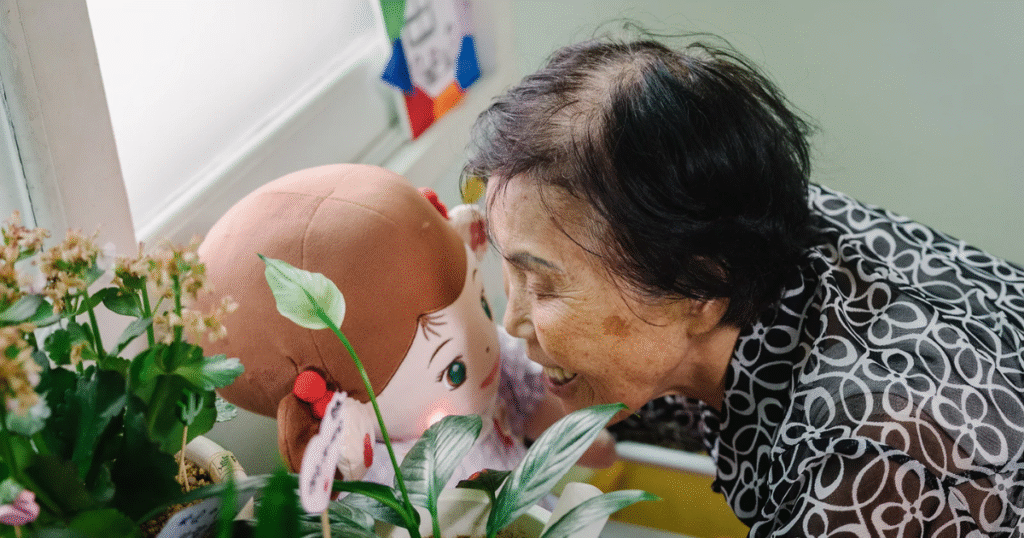The future of senior care is no longer limited to episodic doctor visits or occasional phone check-ins. Companion robots in healthcare are introducing a new model, where monitoring and engagement become constant, seamless, and far less dependent on human availability.
One striking example comes from Seoul’s municipal program Hyodol, a plush robot companion designed to help seniors manage their daily lives. By blending AI with empathetic companionship, programs like this offer a glimpse into how aging services may be transformed worldwide.
TL;DR:
- Companion robots in healthcare shift care from episodic visits to ambient, continuous monitoring.
- Seoul’s Hyodol robot demonstrates how AI agents can remind, check in, and escalate issues to human teams.
- Early evidence suggests improved routines and reduced depressive symptoms.
- Success depends less on hardware and more on workflow redesign and human-robot collaboration.
The Shift from Episodic to Ambient Care
For decades, healthcare and aging services have relied on scheduled appointments and check-ins. This episodic model left gaps where issues could escalate unnoticed. Companion robots in healthcare aim to fill those gaps by creating ambient monitoring environments.
Instead of waiting for the next home visit or phone call, these robots continuously track activity, routines, and even mood. This shift offers potential for early interventions, improved adherence to routines, and a more connected care experience for older adults.
Companion Robots in Healthcare: The Hyodol Program in Seoul
One of the most widely discussed examples is Hyodol, Seoul’s plush “forever-seven-year-old” companion robot.
Hyodol is more than a cute device. It:
- Uses a ChatGPT-based AI agent to remind older adults to eat meals and take medication.
- Monitors inactivity or distress and alerts family members or social workers.
- Analyzes daily voice check-ins with a Microsoft AI model to assess mood for care teams.
This integration demonstrates how companion robots in healthcare can serve as both a daily support tool and a triage mechanism between professional visits.
On Emotional Wellbeing
Early studies show that programs like Hyodol can reduce depressive symptoms and help older adults stick to healthier routines.
However, the effects often fade if the program lacks a strong design. The novelty of interacting with a robot companion can wear off, which makes sustained engagement and workflow integration crucial.
In other words, companion robots in healthcare may spark initial excitement, but long-term success requires intentional planning, ongoing support, and integration into care teams’ routines.
On Care Worker Impact
While seniors benefit from emotional support and structured routines, care workers experience a different side of the technology.
Feedback from Seoul’s program revealed:
- Maintenance burdens: Frequent repairs and technical troubleshooting.
- Training demands: Caregivers often had to coach seniors on device use.
- Workflow redesign: Teams needed to rethink when to intervene and when to let the robot handle daily tasks.
These insights highlight that companion robots in healthcare don’t simply add convenience. They reshape the division of labor, requiring thoughtful workflow redesign and clear handoffs from robots to humans.
Companion Robots in Healthcare: Benefits and Costs
The dual impact of companion robots is clear. On the one hand, they offer:
- Continuous monitoring and mood tracking.
- Improved adherence to medication and routines.
- Early signals for distress, allowing faster interventions.
On the other hand, they introduce:
- Maintenance, training, and repair workloads.
- Costs for both municipalities and care providers.
- Risks of program fatigue without sustained engagement strategies.
This balance of benefits and costs underscores why companion robots in healthcare must be viewed not just as gadgets but as part of a system-level redesign.
The Real Innovation: Workflow Redesign
Hardware may grab headlines, but the true breakthrough lies in how work is reorganized. Companion robots in healthcare will only deliver lasting impact if teams:
- Redesign workflows around human-robot collaboration.
- Define clear handoffs between AI monitoring and human intervention.
- Invest in training and support for both seniors and care workers.
Without this integration, robots risk becoming novelties rather than sustainable solutions. With it, they could fundamentally reshape how societies support aging populations.
FAQs on Companion Robots in Healthcare
1. What are companion robots in healthcare?
They are AI-enabled devices designed to support seniors with daily routines, emotional wellbeing, and continuous monitoring, bridging the gap between visits.
2. How do companion robots like Hyodol work?
They remind seniors to eat and take medications, monitor activity and mood, and alert care teams if issues arise.
3. Do companion robots reduce caregiver workloads?
Yes and no. They handle daily reminders and mood tracking, but they also create new demands such as maintenance and training.
4. What are the risks of companion robots in healthcare?
Potential risks include over-reliance on technology, device fatigue, privacy concerns, and added maintenance burdens for care workers.
5. Will companion robots replace human caregivers?
No. They serve as companions and monitoring tools, not replacements. The goal is to free humans to focus on higher-level, empathetic, and complex care.
Related content you might also like:
- The Future of Healthcare: Embracing the Shift from Digitization to ‘Data’fication
- Transforming Healthcare: Navigating Technological Innovations, Policy Shifts, and Changing Patient Expectations
- Humanoid Robots: The Future of Household Automation—But Not as Soon as You Think
- Assorted Links and Thoughts on Second Screen
- Walmart AI Strategy 2025: Operational Lessons



